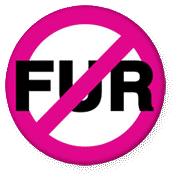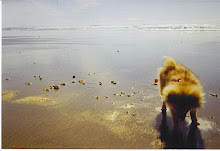
Stick Figure Productions, I Am an Animal: The Story of Ingrid Newkirk and PETA (HBOR documentary, 2007). Sheila Nevins, executive producer; Mikaela Beardsley, Steven Cantor, Pax Wassermann, producers; Matthew Galkin, producer and director.
Reviewer: Claudette Vaughan
For all those conspiracy buffs out there who follow logos in this age of post 9/11, the Illuminati and New World Order, here’s one for you. People for the Ethical Treatment of Animals (PeTA) original logo was the blue bunny’s head. So close in fact is this to Playboy Inc. white bunny’s head one wonders how the similarities could have been missed in the first place…and that just about says it all. When you get down to it that’s why these vampirious organisations were devised in the first place.
PeTA’s modus operandi is identical to that of Playboy Inc’s now. It took a while getting there but it’s all about sex, money, siphoning off the young and marketing to them (sic) exploitation. This is no coincidence. Last week “I Am An Animal: The Story of Ingrid Newkirk and PeTA” aired on HPO television at 8pm and it provided a bird’s eye view at what’s going on over at Norfolk, Virginia.
Twenty-seven years ago People For the Ethical Treatment of Animals (PeTA) was born. Its marketing strategy then was it was prepared to take the world by storm if necessary through a new intense form of activism that demanded that animal abusers, animal eaters and wearers and the biomedical research labs were put on notice.
What happened? PeTA was formed at a time (again no coincidence) when the corporate state was building itself up to be a driver for those who wanted total dominion in the global market for world domination. In business and in war, the Americans have changed the rules, have moved the goal posts, to the detriment of us all and it’s not working.
In “I Am An Animal…” Newkirk came across much the same way as how America is viewed around the globe today – totally un self-reflective and childishly manically egotistical. When Newkirk sacked Chris, that poor and well-meaning undercover worker who hadn’t gotten enough footage for her, it was cringe time all-around and any sympathy for her plight that may have been the case, went right out the door.
You know you’re in trouble when the trailer just after the main program is more interesting (“The Making of Darfur”) than the main program itself.
Ingrid, Ingrid where did it all go wrong for you?
No-body trusts you any longer. Certainly not your co-founder Alex Pacheco who denounced your methods and came out of this doco shining with integrity – shining in remembrance of a by-gone era of unspoken loyalties and unbending will to take them all on for all animals but by no stretch of the imagination is that the PeTA of today.
Those silly silly antics, those naked young women just standing there naked holding their breasts awkwardly and wearing horns, makes you look ridiculous and you know what, I’m sorry to have to say it, but you have no-one but yourself to blame.
And that’s really where the central problem lies. The Cult Of Ingrid Newkirk reigns and like any other cult it’s based around one figure – Newkirk herself.
Following the Hollywood model, either consciously or unknowingly, has been the undoing of People for the Ethical Treatment of Animals. In Hollywood, trash like “The 40 Year Old Virgin”, “Porkys” and “American Pie” -- that movie where the kid masturbates into the apple pie -- is meant to be taken, believe it or not, as “entertainment”. Everything is earmarked for the adolescent but it’s wearing and numbing us all down. The point is this is not a haphazard occurrence, it has diabolical consequences, as does it’s root, and it’s a form of brainwashing.
Sound familiar? Yes, PeTA’s ‘anything goes’ is as unethical and painfully obvious as Hollywood’s is and that’s really saying something. You see, if it was just about PeTA and witnessing the beginnings of their demise as far as serious revolutionary social justice change is concerned, then that would be the end of it, but it’s not just about that.
Something has entered the picture and it’s intention is to bring down the whole of the animal rights movement from within while people are looking away or are looking at naked young breasts from women with glazed over looks in their eyes who have probably convinced themselves they are doing something important for animals. Its rabietic nature is evil itself. It targets children, as PeTA does with their “Your Mommie Kills Animals” charade/propaganda, in exactly the same way MacDonalds targets children. That’s how the Brotherhood in America works. Blaming one another while it’s all the same. Blaming Japanese whalers while you won’t lift a finger in your own country to save a dog.
Perhaps Ingrid Newkirk would have been better off staying in the animal control business from whence she came where she could have euthanased as many animals as her heart desired. To bring that skill over to the animal rights movement, to insert it into the movement, death is death after all, is a diabolical act that destroys an agenda that is aggressively for the love of life, vegan and pro- personhood rights. There’s never any shortage of people on this planet willing to kill animals. How did she keep a straight face when she said she was for “total animal liberation”, I’ll never know. That was an Oscar-winning performance up there with Betty Davis’s “Whatever Happened To Baby-Jane?” or Gloria Swanson’s “Sunset Boulevard”.
When the close-up of Newkirk zoomed in on her explaining why they just had to euthanase a dog she had just rescued after consultation with PeTA’s Dapha Nachminovitch it could have had you weeping in your hanky if you weren’t in receipt of the full facts and figures behind their killing policy. Daphna Nachminovitch, PETA's director of domestic animal welfare, is licensed to administer sodium pentobarbital in Virginia, as I understand it, but is not a vet. Newkirk asks for “the verdict" and Nachminovitch reads notes from somebody’s report, yet if a vet physically examined this dog, we see no sign of it.
Nobody asked Newkirk why she doesn’t rehome animals in any significant numbers. In fact PeTA’s annual re-homing figures are so appalling that local shelters do better than this multi-million dollar organisation that has a declared budget of $25 million to spend and let’s not forget that income tax write off of a state-of-the-art giant freezer to house those dead innocent unassuming bodies in, but you won’t see any of that in this documentary. Newkirk’s opposition to Trap-Neuter-Return for feral cats is legendary while advocating a policy against No-Kill Shelters is a policy that’s in direct contradiction to everything they say they espouse to stand for.
The one success that the international animal rights movement has succeeded in in recent times is preventing Ingrid Newkirk herself from publicly scoffing in the media at No-Kill efforts. As Ingrid herself would say, “It’s another win for the animals.”
I know it suits the media to still portray PeTA as the enfant terrible “radical” of the animal rights movement but it’s not fitting.
The usually tepid Wayne “no surprises here” Pacelle organisation nearly tops the billionaire mark now “for the animals of course” derides PeTA as “shock jocks” in this documentary. Well, that’s rich coming from the Humane Society of America who is in the league of watered-down animal welfarism themselves, whose major talent lies in knowing their way around a corporate boardroom coupled with the in’s and out’s of the latest American marketing strategies.
PeTA is looking tired and strangely pathetic, often menacing these days. Newkirk reiterates that old song of hers that sex and violence is the only thing that turns people on so therefore by inference they have to do things they do, she says, for attention, but by opening that door, by dropping their ethical defenses from out of their itinerary in the struggle for animal dignity, invites those very same forces in. It’s a recipe for disaster and who is going to take seriously a woman who says that in the first place? Newkirk herself blames the edit in a recent interview but could she not honestly gauge that it was coming?
In the kooky, spooky world of PeTA the eerie ghoulish line they have chosen to pursue insists they’re against the fleecing of sheep, right? Yet they don’t seem to mind, one senses, the fine art of fleecing human beings out of their life savings and good will. Frankly, there’s nothing new in taking the ethical guts out of a new movement but PeTA has made a cult out of it and that can’t be good.
A few asides. The cameo appearances of Alex Pachecho, Priscilla Feral from Friends of Animals and Mr Abraham Foxman from the Jewish Defamation League on PeTA’s analogy of the Jewish Holocaust with the animal holocaust stole the show because, get this Ingrid, they oozed integrity. Integrity works (surprise, surprise) but you can’t manufacture it from outside. It’s got to be produced from within.
Another thing: Blaming religion for the plight of animals is hollow rhetoric. Christ Crucified knew what human beings are capable of. The Redemption itself, if you study religion – Christ made not man-made - typifies this.
As for ethics, does this really need spelling out? Arson is not the lesser evil. There’s nothing cool or hip or anything important to be gained at any time from glamourising arson as a doable tool for the animals.
The truth is if I had a daughter she would not be allowed near the PeTA headquarters to volunteer her precious time and resources. She’s not a free resource.
If one looks closely at this documentary the term “animal rights” is never discussed. It’s the same in Australia. It’s just all about just “helping” animals these days. Helping them out. Since America has such a poor human rights record should one really be surprised that rights for animals are not being discussed any longer by the largest “animal rights organisation” in the world. Weird eh? There’s more.
I Am An Animal is also a unintentional look at how the world is being carved up into rich and poor. The charities of the future, and this started in the 70’s, will either abide by the dictate to become multi-million dollar businesses or they will be relegated to a sentimentalist category - “poor but kind” status symbols of second hand opportunity shops with no money forth coming. It’s called New World Order.
As Robert Kennedy said about it before he was assassinated: "We shall have World Government, whether or not we like it. The only question is whether “All of us will ultimately be judged on the effort we have contributed to building a NEW WORLD ORDER."
In this context, PeTA is right up there with the big players, unfazed, unconscionable and for the most part, unaccountable, that is for the present moment anyway.
Ingrid Newkirk might disagree with this feature of PeTA’s but just ask yourself one thing: Does George W Bush know what’s going on at that level?

















